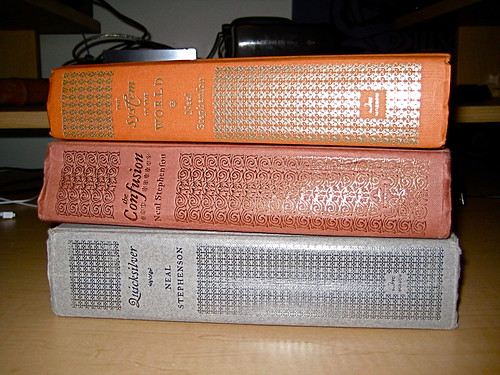On Books
I’ve never found any appeal in general social networking sites like MySpace or Facebook. They seem pointless. Sites that primarily serve some actual function and secondarily offer social networking features make more sense to me – something like Flickr: a photo hosting site that happens to offer social networking features. And now I’ve signed up for LibraryThing: a book catalog service that happens to have some social networking.
A friend recently told me about LibraryThing. It appealed to me as a way to keep track of all my books, and I thought it might be interesting to see who else owned copies of some of the more obscure books in my collection. I intend only to add books that I actually own to LibraryThing – not all the books I’ve read, which would take far too long. This makes LibraryThing’s recommendation service rather irrelevant for me, since most of the books it currently recommends are those that I have read, but do not own.
It appears that I currently own 160 books. Over the past year I’ve been heavily pruning my library, getting rid of a great many books. The remainder is probably one quarter the size of what it used to be. It is made up of books that I like and reread frequently, or that I find significant, or that serve as reference material. I’ve tried to do away with all the books I owned that I didn’t think I’d ever read again (no matter how much I like them). Now that I have an accurate count of my books, I think I’ll continue pruning till I get the collection down to 100 (quite a ways away from the cult of less or 100 things challenge, but I’m getting there.) It promises to be difficult!
It used to be that I didn’t have a bookshelf. All my books were just in stacks on the floor. I still don’t have a bookshelf, but a few years ago I came up with a solution while reading The Dharma Bums. Japhy Ryder – the character based on Gary Snyder – is described as owning little other than mountaineering equipment and books. The books he stores in crates. I thought it was a great idea, and promptly went out to acquire a collection of milk crates for my own. The crates can be stacked against a wall to function as a bookshelf and, when moving, all the books are already boxed and ready for transport! Multifunction.
About a mile from there, way down Milvia and then upslope toward the campus of the university of California, behind another big old house on a quiet street (Hillegass), Japhy lived in his own shack which was infinitely smaller than ours, about twelve by twelve, with nothing in it but typical Japhy appurtenances that showed his belief in the simple monastic life – no chairs at all, not even one sentimental rocking chair, but just straw mats. In the corner was his famous rucksack with cleaned-up pots and pants all fitting into one another in a compact unit and all tied and put away inside a knotted-up blue bandana… He had a slew of orange crates all filled with beautiful scholarly books, some of them in Oriental languages, all the great sutras, comments on sutras, the complete works of D.T. Suzuki and a fine quadruple-volume edition of Japanese haikus. He also had an immense collection of valuable general poetry. In fact if a thief should have broken in there the only things of real value were the books. Japhy’s clothes were all old hand-me-downs bought secondhand with a bemused and happy expression in Goodwill and Salvation Army stores: wool socks darned, colored undershirts, jeans, workshirts, moccasin shoes, and a few turtleneck sweaters that he wore one on top the other in the cold mountain nights of the High Sierras in California and the High Cascades of Washington and Oregon on the long incredible jaunts that sometimes lasted weeks and weeks with just a few pounds of dried food in his pack.

